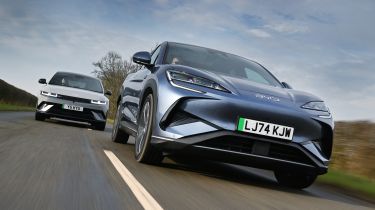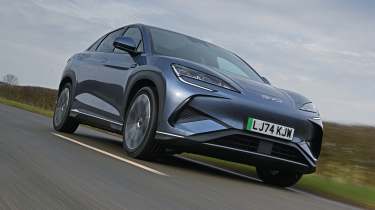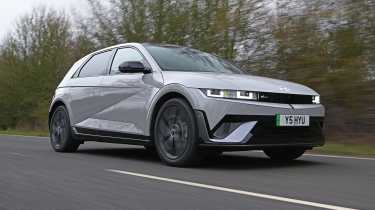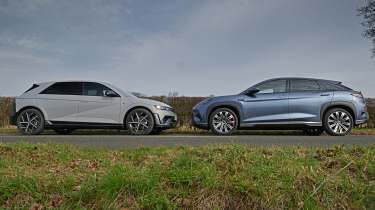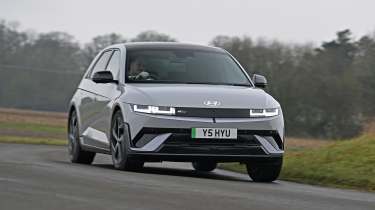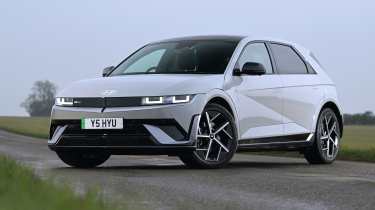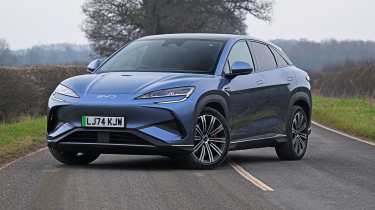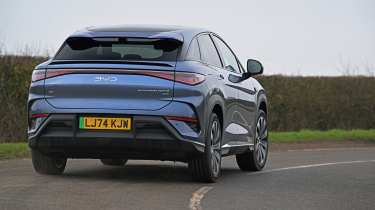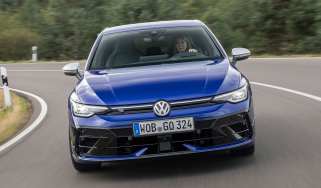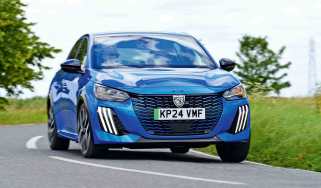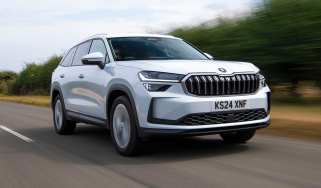Hyundai Ioniq 5 vs BYD Sealion 7: can the fresh arrival defeat a firm favourite?
BYD’s latest arrival in the UK is the Sealion 7, and among the models the Chinese EV has in its sights is our 2021 Car of the Year, the Hyundai Ioniq 5
Go back barely a couple of years, and hardly anyone in this country would have any idea who, or what, BYD was. Maybe if you were a battery nerd, or you had an interest in buses then there would have been a chance, but that would have been the limit of its reach.
Yet since 2023, the Chinese brand has gone from zero to five distinct models, marking a rapid expansion rarely seen before in the UK.
The fifth car to join the range is the Sealion 7, which sits alongside its other aquatic-based rangemates, such as the Seal and Dolphin. Yet this EV arguably represents BYD’s toughest challenge to date, because it wades into a class of very competitive pure-electric SUVs.
The progress in the EV space means that one year’s Car of the Year winner can be next year’s also-ran, but one model which has managed to resist the march of progress better than most is the Hyundai Ioniq 5.
Not only did the marque get so much right in the first place, but our favourite car of 2021 has since received a range of minor upgrades to keep it competitive, too. Have these gone far enough to compete with the latest car from one of the strongest new brands to emerge from China? Read on to find out.
BYD Sealion 7
| Model: | BYD Sealion 7 Design AWD |
| Price: | £49,290 |
| Powertrain: | 82.5kWh battery, 2x e-motors, 523bhp |
| 0-62mph: | 4.5 seconds |
| Test efficiency: | 2.6 miles/kWh |
| Official range: | 283 miles |
| Annual VED: | £620 (from 1 April 2025) |
For a brand that’s relatively new to the UK, BYD hasn’t been shy about wading into some very competitive segments. More often than not, it has acquitted itself well, too.
Used - available now

2023 MINI
Cooper Electric
17,042 milesAutomaticElectric
Cash £12,300
2021 Volkswagen
ID.3
36,347 milesAutomaticElectric
Cash £14,600
2023 Jaguar
I-PACE
56,034 milesAutomaticElectric
Cash £20,700
2023 Audi
e-tron
38,468 milesAutomaticElectric
Cash £17,700The Atto 3 and Dolphin, its two smallest offerings to date, are its strongest models. And even though the Seal saloon can’t quite live with the best in the class, it’s still a compelling compact executive car in its own right. The Sealion 7 has the toughest task yet, though, pitching itself against everything from the Skoda Enyaq, Tesla Model Y and Hyundai Ioniq 5 to the Renault Scenic and Ford Capri.
Tester's notes
Our Sealion 7 efficiency scores in the UK looked okay, if not outstanding for the class. They drew roughly level with the Ioniq 5’s, which are also average in this segment. It’s also worth noting that our initial drives of the car in Germany, including some autobahn running, harmed the range further.
Even at 70mph, we’ve found that many alternatives – particularly the Tesla Model Y and rivals from the VW Group – use less energy, so we’d look to one of those cars if you plan on finding an EV to do lots of motorway journeys.
Hyundai Ioniq 5 N
| Model: | Hyundai Ioniq 5 N Line Long Range AWD |
| Price: | £50,900 |
| Powertrain: | 84kWh battery, 2x e-motors, 321bhp |
| 0-62mph: | 5.3 seconds |
| Test efficiency: | 2.6 miles/kWh |
| Official range: | 307 miles |
| Annual VED: | £620 (from 1 April 2025) |
It seems amazing to say it, but the Hyundai Ioniq 5 is one of the longest-serving cars in this class now, such is the rate of progress and expansion of the family EV segment. Our 2021 Car of the Year isn’t simply lying down to let the latest competition walk all over it, though, because it’s received a number of nips and tucks for 2025.
Key among them for buyers who drive long distances will be the updated battery pack, which increases capacity from 77.4kWh to 84kWh. Along with tweaked aerodynamics, this has boosted the car’s range.
There are also changes to the interior and safety tech, while various chassis upgrades are designed to elevate the 5’s drive. A new shock absorber design aims to improve the ride, with a tougher cowl crossbar set to reduce steering vibration.
Reinforced sections around the rear axle look to boost stability and agility; they also reduce road noise, as has the addition of more sound insulation around the rear motor. The B-pillars have been toughened to improve protection in a side-on collision.
Tester's notes
Of all the detailed design tweaks that Hyundai has introduced for 2025, one of the simplest is also one of the most welcome. That’s because now the Korean brand has finally seen sense and fitted a rear window wash/wipe system to the Ioniq 5.
While Hyundai isn’t the only firm guilty of not fitting one previously, it was silly to assume that the car’s aerodynamics would always keep it clean. In reality, you had to travel at motorway speeds to prevent it from collecting spray and grime – a concern that is now a thing of the past.
Head-to-head
On the road
There’s a clear jiggle to the BYD’s ride, which suggests its suspension is firm, but find a twisty road and it feels heavy and prone to body roll. The Hyundai is softer over bumps, yet still feels better tied-down through corners. It’s all relative, however, and even the Hyundai isn’t particularly sharp to drive. On paper, the Sealion is a little quicker than the Ioniq 5, but on the road it feels like there’s little to separate them.
Tech highlights
On the face of it, the BYD has the edge when it comes to battery capacity and outright power. But at nearly 2.4 tonnes, it’s more hefty than the 2.2-tonne Hyundai, too. The Ioniq 5’s 800-volt set-up allows it to recharge at up to 233kW, enabling a 10-80 per cent top up in just 18 minutes. The BYD’s maximum rate of 150kW can’t match its rival’s, and several other class contenders also have a higher peak rate.
Price and running
Testing in cold weather really showed just how much temperature affects efficiency. Both cars recorded 2.6 miles/kWh, which seems low, but we have previous experience with the Hyundai as a yardstick. We ran a pre-update Ioniq 5 on our long-term test fleet, and averaged 3.8mi/kWh in warmer weather. The Sealion’s stronger resistance to depreciation helps with its running costs.
Practicality
Neither car has class-leading space or practicality as an overall package. Both offer excellent rear legroom, but the Sealion’s headroom is disappointing for a model of this size. The Ioniq 5’s 520-litre boot is impressive on paper, but it’s fairly shallow, while the BYD’s has the same volume, yet is deeper and more useful. Both have front boots, but twin-motor Ioniq 5s get a 24-litre capacity; the Sealion 7 offers 58 litres.
Safety
Two things are very clear when driving these cars: both are loaded with standard safety tech, and both like to bong relentlessly with various warnings and alerts. But we find that although the Ioniq 5’s systems aren’t perfect, they are less intrusive to use while driving and are easier to switch off if you’d prefer to do without them. The Sealion’s lane-keep assist is far too aggressive with its corrections.
Ownership
Six and five-year warranties for the BYD and Hyundai respectively put both cars towards the top of the class for overall cover, while the Sealion 7 also gets a generous four years of breakdown assistance as standard. BYD has yet to be surveyed in our Driver Power customer satisfaction polls, while Hyundai was a little below the industry average last year, taking 17th overall out of 32 manufacturers.
Verdict
Winner: Hyundai Ioniq 5
Four years on from its launch and the Hyundai Ioniq 5 remains one of the most convincing and desirable family EVs money can buy. The updates introduced for 2025 have made an already impressive car even more likeable, with minor upgrades to its range, comfort, refinement and tech all making small but positive changes to the overall package.
Interior space is excellent, the drive is relaxing and smooth, and performance is competitive for the segment – even if the Sealion is marginally quicker. That one area aside, the Ioniq 5 has its Chinese challenger covered in almost every respect.
Runner-up: BYD Sealion 7
Depending on your priorities, the Sealion could be a very compelling car to live with. Few models in the class offer as much standard equipment, and even fewer are backed up by such a competitive breakdown and warranty package. Rear legroom is fantastic, too, even if headroom is tighter than we’d like.
However, the main issues come elsewhere: the chassis falls behind the competition in terms of ride and handling, the safety tech irritates and some models look pricey – despite their strong performance. None
of these flaws is so fundamental that they couldn’t be fixed in a mid-life refresh, though.
Prices and specs
| BYD Sealion 7 | Hyundai Ioniq 5 | |
| Our choice | Design AWD | N Line Long Range AWD |
| Price from/price of our choice | £49,290/£49,290 | £50,900/£50,900 |
| Powertrain and performance | ||
| Powertrain | 2x electric motors | 2x electric motors |
| Power | 523bhp | 321bhp |
| Torque | 690Nm | 605Nm |
| Transmission | Single-speed/awd | Single-speed/awd |
| 0-62mph/top speed | 4.5 secs/134mph | 5.3 secs/114mph |
| Battery capacity | 82.5kWh | 84kWh |
| Official range | 283 miles | 307 miles |
| Test efficiency/range | 2.6mi/kWh/215 miles | 2.6mi/kWh/218 miles |
| Charging | 150kW (10-80% 32 mins) | 233kW (10-80% in 18 mins) |
| Dimensions | ||
| Length/wheelbase | 4,830/2,930mm | 4,655/3,000mm |
| Width/height | 1,925/1,620mm | 1,890/1,605mm |
| Rear kneeroom | 737-995mm | 695-935mm |
| Rear headroom/elbow room | 879/1,504mm | 930/1,590mm |
| Boot space (front/seats up/down) | 58/520/1,789 litres | 24/520/1,580 litres |
| Boot length/width | 1,041/1,010mm | 985 (1,185*)/1,040mm |
| Boot lip height | 771mm | 730mm |
| Kerbweight/towing weight | 2,340/1,500kg | 2,190/1,600kg |
| Turning circle | 11.7 metres | 12.0 metres |
| Costs/ownership | ||
| Residual value (after 3yrs/36,000 miles) | £25,202/51.13% | £22,024/43.27% |
| Depreciation | £24,088 | £28,876 |
| Ins. group/quote/VED | 47/N/A/£620 | 41/£1,028/£620 |
| Three-year service cost | TBC | £302 |
| Annual tax liability std/higher rate | £312/£623 | £305/£610 |
| Annual fuel cost (10k miles) | £1,100 | £1,100 |
| Basic warranty (miles)/recovery | 6yrs (93k)/4yrs | 5yrs (unlimited)/1yr |
| Driver Power manufacturer position | N/A | 17th |
| NCAP Adult/child/ped./assist/stars | TBC | 88/86/63/88/5 (2021) |
| Equipment | ||
| Metallic paint/wheel size | £1,100/20 inches | £700/20 inches |
| Parking sensors/camera | F&r/yes | F&r/yes |
| Spare wheel/Isofix points | Repair kit/three | Repair kit/three |
| Keyless entry & go/powered tailgate | Yes/no | Yes/yes |
| Leather/heated seats | Yes/yes | Part/yes |
| Screen size/digital dashboard | 15.6 inches/yes | 12.3 inches/yes |
| Climate control/panoramic sunroof | Yes/yes | Yes/no |
| USBs/wireless charging | Four/yes | Five/yes |
| Wireless CarPlay/Android Auto | Yes/yes | Yes/yes |
| Blind-spot warning/head-up display | Yes/yes | Yes/no |
| Adaptive cruise/steering assist | Yes/yes | Yes/yes |
What we would choose
BYD Sealion 7: Each Sealion 7 in the range is so well equipped that there’s little scope for adding any optional extras. But we’d like more choice when it comes to paint colours; there are just four to choose from – none of which are exciting.
Hyundai Ioniq 5: The range-topping Ioniq 5 Ultimate can be customised with several option packs, which include remote parking and a 360-degree camera. Ultimate and N Line S trims are optionally available with digital side mirrors.
Our dealer network has 1,000s of great value new cars in stock and available now right across the UK. Find your new car…

